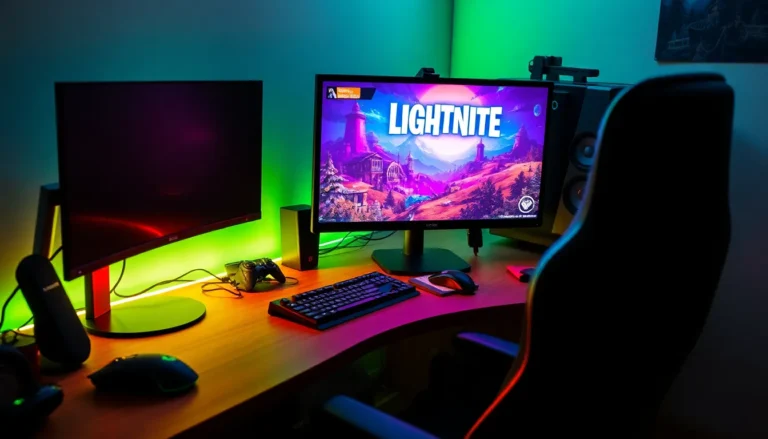Table of Contents
ToggleIn a world where laptops reign supreme, choosing the right Linux distro can feel like picking a favorite child—impossible! With countless options, each promising to be the best thing since sliced bread, it’s easy to get lost in the sea of penguins. But fear not, tech-savvy adventurers! The quest for the perfect Linux distro is about to get a lot easier.
Overview of Linux Distros for Laptops
Selecting the best Linux distribution for laptops involves understanding various options tailored for performance and usability. Each distro offers distinct features that can enhance the laptop experience. Popular choices include Ubuntu, Fedora, and Mint, which provide user-friendly interfaces and excellent community support.
Ubuntu stands out with its polished interface and extensive software library. This distro appeals to newcomers and experienced users alike due to its ease of installation and strong documentation. Fedora, known for its cutting-edge technology, regularly incorporates the latest advancements, making it suitable for users seeking the newest features.
Linux Mint emphasizes a comfortable user experience, drawing in users transitioning from Windows. Its familiar desktop environment helps bridge the gap and eases the learning curve. Additionally, Manjaro attracts tech-savvy users with its Arch-based infrastructure, providing flexibility and extensive customization options.
Battery performance is vital for users, especially on laptops. Distros like Xubuntu and Lubuntu focus on lightweight environments, optimizing resource usage to extend battery life. These lightweight options perform well on older hardware, making them ideal for budget-conscious users.
Overall, selecting a Linux distro for laptops hinges on individual preferences and hardware specifications. Prioritizing performance, user experience, and community support leads to a fulfilling and productive computing environment.
Factors to Consider When Choosing a Distro

Choosing the right Linux distro involves several important factors. Understand the specific hardware and personal preferences to ensure an optimal experience.
Hardware Compatibility
Hardware compatibility carries significant weight in the decision-making process. Many distributions provide better support for specific hardware configurations. Prioritize distros that cater to your laptop’s chipset and drivers, ensuring smooth performance. Distributions like Ubuntu and Fedora frequently update their kernels, enhancing compatibility with the latest devices. Users of older laptops might benefit from lighter options like Xubuntu or Lubuntu, designed for less demanding systems. Always check community documentation before installation to confirm driver support and required configurations.
User Interface Preferences
User interface preferences shape the overall experience with a Linux distro. Different distributions offer diverse desktop environments, each presenting unique aesthetics and functionality. Some users favor the simplicity of GNOME, while others prefer the traditional look of XFCE or KDE. Familiarity often eases the transition from Windows; Linux Mint mimics its layout effectively. Experimenting with live USB versions can help you find the interface that feels intuitive. This step saves time and stress when committing to a full installation.
Top Recommendations for Best Linux Distro for Laptops
Choosing the right Linux distro for laptops involves careful consideration of user needs and hardware compatibility. Here are some top recommendations.
Ubuntu
Ubuntu stands out for its polished, user-friendly interface and extensive software repository. New users often appreciate its simplicity, while experienced users value its reliability. Regular updates keep the system secure and compatible with various hardware. Developers support a wide range of applications, from multimedia tools to productivity software. Overall, Ubuntu provides a robust choice for those seeking a versatile operating system.
Linux Mint
Linux Mint offers a familiar desktop environment, making it a go-to option for those transitioning from Windows. Its Cinnamon desktop provides intuitive navigation and an appealing look. Users benefit from the easy installation of software through the package manager. The distro emphasizes stability and performance, providing a solid experience for daily tasks. Additionally, Linux Mint is well-suited for users who prefer a traditional desktop setup.
Fedora
Fedora is known for its leading-edge technology and commitment to open-source software. It caters to developers and tech enthusiasts by integrating the latest features and applications. Regular updates ensure a modern computing experience, with a focus on security and innovation. Users can experiment with different desktop environments, giving flexibility in customization. Fedora’s robust community support further enhances its appeal.
Manjaro
Manjaro combines ease of use with the power of Arch Linux, making it an excellent choice for desktop users. With a rolling release model, the system remains up-to-date without major upgrades. Users enjoy multiple desktop environments, allowing for personalized experiences. Performance is optimized for various hardware, making it suitable for older laptops as well. The active community contributes to its growing library of documentation and support.
Pop!_OS
Pop!_OS is tailored for laptop users, especially those engaged in programming and creative tasks. The interface focuses on productivity with a clean, user-friendly layout. Enhanced support for gaming and development tools makes it appealing for technical users. Regular optimizations and performance improvements help ensure a smooth experience. Pop!_OS also includes features that streamline workflows, boosting efficiency for power users.
Performance and Usability Comparison
Evaluating performance is essential when selecting a Linux distribution for laptops. Ubuntu excels in providing a polished user interface along with a vast software library. Users often find its responsiveness appealing, especially on modern hardware.
Fedora, recognized for its cutting-edge features, prioritizes the latest technologies. Those who enjoy experimenting with new advancements often prefer it for its commitment to innovation.
On the other hand, Linux Mint stands out with its familiar desktop interface, which eases the transition for Windows users. Its usability and reliability make it a strong option for those who value comfort alongside performance.
For older hardware, lightweight distributions like Xubuntu and Lubuntu optimize battery performance effectively. Many users choose these options for a smoother experience on less capable systems. They provide essential functionalities without overwhelming resources.
Mobile device support further differentiates these distributions. Ubuntu and Fedora frequently receive kernel updates to improve compatibility across a wide range of laptops. This regular attention ensures users encounter fewer technical issues.
User interface considerations should guide the decision-making process as well. Each distribution offers distinct desktop environments that cater to various preferences. Experimenting with live USB versions enables users to identify which layout resonates most with their workflow.
Community support is another factor impacting usability. A robust user community often accompanies popular distributions, providing ample resources for troubleshooting and guidance. Engaging with these communities can make navigating challenges more manageable.
Overall, users often find the choice of distribution aligns closely with their hardware specifications and performance expectations. Prioritizing these factors enhances the overall computing experience on laptops.
Choosing the right Linux distribution for laptops can significantly enhance the user experience. With options like Ubuntu, Linux Mint, and Fedora, users can find a distro that aligns with their needs and hardware specifications. Lightweight alternatives such as Xubuntu and Lubuntu cater to older machines, ensuring optimal performance and battery life.
Ultimately, the best choice depends on individual preferences regarding interface and functionality. By exploring different distributions and engaging with their communities, users can discover the perfect Linux environment that meets their requirements. Embracing the right Linux distro can lead to a more efficient and enjoyable computing experience on any laptop.





